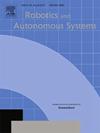A wearable exoskeletal lumbar spinal rehabilitation robot based on sliding mode control scheme
IF 4.3
2区 计算机科学
Q1 AUTOMATION & CONTROL SYSTEMS
引用次数: 0
Abstract
Low back pain has become the leading cause of nonfatal health damage in the world, and about 80% of people are affected at some stage of their lives. Lumbar disc herniation (LDH) is the most common clinical cause of low back pain, of which nonsurgical treatment of lumbar traction combined with long-term bed rest can cure 80% to 90% of patients clinically. However, long-term bed rest is difficult to achieve for many people, and the use of traction equipment is expensive and inconvenient. In this paper, we developed a wearable exoskeletal lumbar rehabilitation robot (WELRR) to replace the traditional treatment of mechanical traction and long-term bed rest. The WELRR allows people to continuously wear at work and life with lumbar vertebra supported. In addition, for patients that require 2-3 months of rehabilitation after lumbar disc surgery, the robot can be used to help maintain the stability of the lumbar spine, gradually increase the range of motion of the lumbar spine in patients, and avoid muscle atrophy. The WELRR adopts the 4UPS+PS parallel bionic mechanism and sliding mode control scheme based on the linear extended observer. We verified the usability of WELRR through two experiments. In the first experiment, the maximum range of waist movement allowed by the WELRR was verified, which can meet the freedom of movement required by the human body in daily life. In the second experiment, by gathering and comparing the EMG signal of the erector spinae muscle, the use of the WELEE could reduce the EMG signal amplitude. The EMG signal while wearing the WELRR under vertical standing reached the same EMG signal level in a relaxed state, and the effectiveness of lumbar spinal decompression was verified. At present, the WELRR system is undergoing changes and testing prior to clinical trials.
一种基于滑模控制方案的可穿戴外骨骼腰椎康复机器人
腰痛已经成为世界上非致命性健康损害的主要原因,大约80%的人在他们生命的某个阶段受到影响。腰椎间盘突出症(LDH)是临床上引起腰痛最常见的原因,其中腰椎牵引结合长期卧床休息的非手术治疗在临床上可治愈80% ~ 90%的患者。然而,长期卧床休息对很多人来说很难实现,而且使用牵引设备既昂贵又不方便。在本文中,我们开发了一种可穿戴的外骨骼腰椎康复机器人(WELRR),以取代传统的机械牵引和长期卧床治疗。WELRR允许人们在工作和生活中持续佩戴腰椎支撑。此外,对于腰椎间盘手术后需要2-3个月康复的患者,可以利用机器人帮助维持腰椎的稳定性,逐渐增加患者腰椎的活动范围,避免肌肉萎缩。WELRR采用4UPS+PS并联仿生机构和基于线性扩展观测器的滑模控制方案。我们通过两个实验验证了WELRR的可用性。在第一个实验中,验证了WELRR允许的最大腰部运动范围,该范围能够满足人体在日常生活中所需要的运动自由度。在第二个实验中,通过对竖脊肌肌电信号的采集和比较,发现利用WELEE可以降低肌电信号的幅值。佩戴WELRR直立站立时的肌电信号达到放松状态时的肌电信号水平,验证了腰椎减压的有效性。目前,WELRR系统正在进行临床试验前的修改和测试。
本文章由计算机程序翻译,如有差异,请以英文原文为准。
求助全文
约1分钟内获得全文
求助全文
来源期刊

Robotics and Autonomous Systems
工程技术-机器人学
CiteScore
9.00
自引率
7.00%
发文量
164
审稿时长
4.5 months
期刊介绍:
Robotics and Autonomous Systems will carry articles describing fundamental developments in the field of robotics, with special emphasis on autonomous systems. An important goal of this journal is to extend the state of the art in both symbolic and sensory based robot control and learning in the context of autonomous systems.
Robotics and Autonomous Systems will carry articles on the theoretical, computational and experimental aspects of autonomous systems, or modules of such systems.
 求助内容:
求助内容: 应助结果提醒方式:
应助结果提醒方式:


